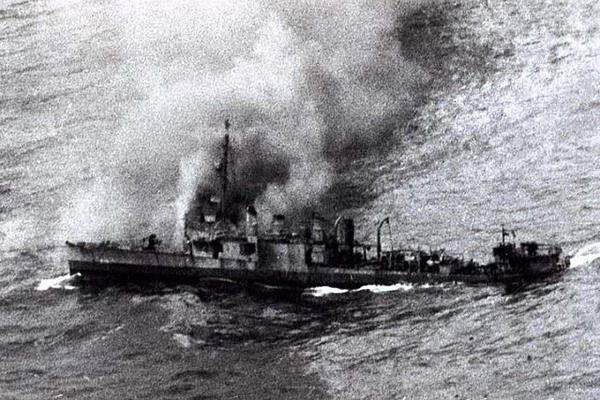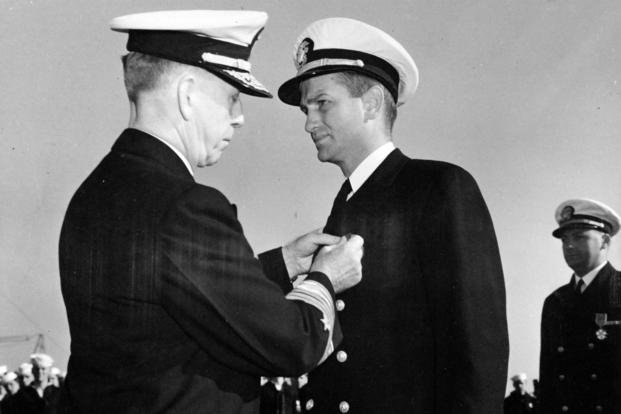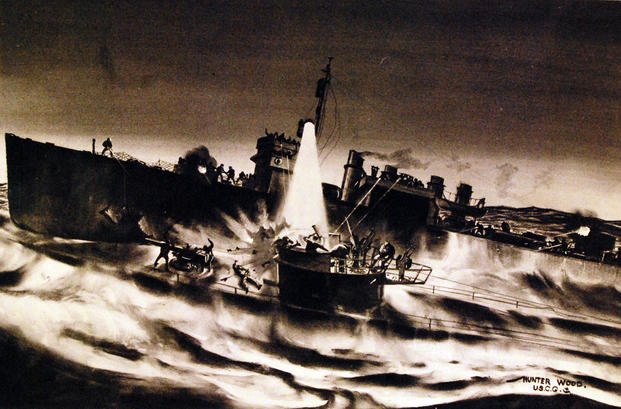As the USS Borie prepared to ram a German U-boat in the early morning hours of Nov. 1, 1943, the sailors on the Navy destroyer braced for impact. Turbulent waters in the north Atlantic Ocean negated the possibility of a head-on strike, though, producing a sudden wave that lifted the Borie off its intended course.
Instead, the Borie landed on the sub's foredeck, locking the ships together for an incredibly fraught 10 minutes of what would become an hourlong engagement widely considered by military historians as "the most spectacular surface battle since the days of John Paul Jones."
It was unlike anything that Robert Maher, a fire controlman first class who was the gun director pointer on the Borie, had ever seen. "It looked more like a Hollywood epic than an actual battle," Maher wrote in a 1993 Naval History Magazine article.
Commissioned in 1920, the Borie was named after Adolph E. Borie, who served a short stint as secretary of the Navy under President Ulysses S. Grant in 1869. The Clemson-class destroyer had served around the world by the time it was assigned to Task Force 21.14, a hunter-killer group in search of U-boats, during World War II. The USS Card, an escort carrier, and the destroyers USS Goff and USS Barry rounded out the task force.

The German submarine U-405 was on a refueling run north of the Azores on the night of Oct. 31, 1943, when the Borie first made contact. After the warship fired a depth charge at the sub, a malfunction involving the stern tracks propelled the Borie's stern out of the water and forced U-405 to the surface.
With its searchlight on, the Borie approached U-405, which was unable to submerge as it was bombarded by persistent gunfire. German sailors moved furiously to man their deck guns, but almost all were killed before reaching their weapons. The sub's crew fired flare guns, and a sailor on the conning tower waved his arms in a plea for the Borie to stop shooting. Navy Lt. Charles Hutchins, the Borie's captain, ordered his men to cease firing, but a sailor had taken off his headphones and didn't hear his captain's demand. He kept shooting, decapitating the pleading sailor.
"It was a sight that was to give me nightmares for months," Maher recalled.
The Borie continued its unrelenting barrage of gunfire, and as the destroyer came within striking distance of the sub, Hutchins bellowed: "Stand by for a ram!" U-405 Capt. Rolf-Heinrich Hopman tried to avoid contact, but the sub turned too late. The stormy seas caused the Borie to land on top of U-405's deck at a 30-degree angle.
With the ships interlocked, some of the Borie’s crew manned 20mm Oerlikon antiaircraft cannons and four-inch guns, and others picked up Thompson submachine guns, shotguns and pistols. In one historical account, a fireman first class killed a German sailor by hurling a sheath knife at him, while in another, a chief boatswain's mate knocked a submariner into the water with a shell casing.
In the chaotic aftermath after the ships separated, the Borie fired a torpedo at U-405 but missed. U-405 started turning in a tight circle -- something the much larger Borie could not duplicate -- the maneuver resulting in the sub's stern tube pointing at the destroyer. This time, U-405 tried to ram the Borie, but three depth charges stopped its advance and narrowly averted another collision.
U-405 finally surrendered after being struck by another barrage from the Borie’s four-inch, prompting "a yell that went up from all hands -- it probably could be heard in Berlin," Hutchins wrote. All 49 German sailors were killed, either during the fighting or when the Borie zigzagged to avoid a torpedo from another U-boat, inadvertently hitting rafts of survivors.
By that point, the Borie was struggling to stay afloat, its collision with U-405 damaging the destroyer's entire port side and almost completely flooding the engine room with bitterly cold, neck-high water. While the crew scrambled valiantly to keep the power on during the Borie's engagement with U-405, eventually the electrical system died, sailors began dumping equipment, weapons and ammunition overboard, and saltwater contaminated its fuel and the boilers’ water supply.

By 9 a.m. on Nov. 1, the Borie's last turbine stopped functioning. Despite the tremendous hardship, some ingenious radiomen got an auxiliary generator working long enough for the destroyer to message the USS Card: "Commenced sinking." The Card promptly launched two aircraft, and after one plane found the stricken ship 14 miles away, the USS Goff (and later the USS Barry) was deployed to the area.
The Borie was beyond saving, though, and Hutchins gave the order to abandon ship at 4:30 p.m. on Nov. 1, 1943. Twenty-seven men died during the rescue effort because of the frigid water and weather, along with the imposing waves that caused the rafts to roll constantly. None of the Borie’s sailors died during the battle.
A combination of bombs from the USS Card's planes and depth charges sank the Borie on the morning of Nov. 2. "She still went down as a valiant lady," Maher wrote.
The Borie’s crew was awarded a Presidential Unit Citation, and Navy Crosses were bestowed to Hutchins, Machinist's Mate 2nd Class Irving Saum and posthumously to Lt. Morrison Brown, the Borie's engineering officer. The destroyer received three battle stars for her WWII service.
Maher wrote about his experience in the book "Sailors' Journey into War," and a second USS Borie was commissioned in September 1944 -- less than a year after the fateful clash between its namesake and a German U-boat.
Want to Know More About the Military?
Be sure to get the latest news about the U.S. military, as well as critical info about how to join and all the benefits of service. Subscribe to Military.com and receive customized updates delivered straight to your inbox.















